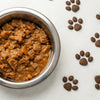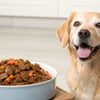Understanding How Much Wet Food Should a 20 lb Dog Eat
- Houndsy
Table of Contents
- Introduction
- Understanding Your Dog's Nutritional Needs
- The Benefits of Wet Dog Food
- Our Approach at Houndsy
- Calculating the Right Amount for a 20 lb Dog
- Considerations for Mixing Canned and Dry Food
- Adjusting Feeding Based on Life Stages and Health Needs
- Conclusion
Introduction
Did you know that around 59% of dogs in the United States are considered overweight or obese? This staggering statistic emphasizes the critical importance of understanding our canine companions' dietary needs, especially how much wet food they should consume daily. As dog lovers and caretakers, we want to ensure our furry friends receive not just enough food but the right amount that supports their overall well-being.
In this blog post, we will explore the factors influencing how much wet food a 20 lb dog should eat. We aim to clarify feeding guidelines, the benefits of wet food, and how we can better manage our pets' diets for optimal health. By the end of this article, you will have a clearer understanding of portion sizes for wet dog food and how to integrate our innovative Houndsy Kibble Dispenser into your feeding routine to enhance the experience even further.
We invite you to reflect on your pet's current feeding practices as we navigate this essential topic together. Let's dive into the world of proper pet nutrition and learn how to make mealtime a joyful ritual!
Understanding Your Dog's Nutritional Needs
Feeding our dogs requires a tailored approach; there is no one-size-fits-all solution. Several factors determine how much wet food a dog, especially one weighing 20 lbs, should eat:
-
Dog's Weight
- The more a dog weighs, the more food they require. For a 20 lb dog, the daily food intake will typically vary based on factors like activity levels and life stages.
-
Activity Level
- Dogs that are more active will need more calories than their less active counterparts. An active 20 lb dog engages in regular exercise and play, requiring extra energy, whereas a sedentary dog needs less.
-
Age and Life Stage
- Puppies require more nutrients per pound than adult dogs since they are in a constant state of growth. In contrast, senior dogs usually need fewer calories due to decreased activity levels.
-
Health Status
- Any health concerns can influence dietary needs. For instance, dogs with diabetes or specific dietary restrictions may require lower calorie foods or specially formulated diets.
-
Types of Food
- The caloric density of wet food can vary significantly among brands and formulations. Therefore, it's essential to check the nutritional content before deciding on the right amount for your dog.
Feeding Guidelines for a 20 lb Dog
For a dog weighing 20 lbs, a general recommendation from most dog food brands would be approximately one can of wet dog food per 10-15 lbs of body weight per day. This means your 20 lb dog may require about 1.5 to 2 cans of wet dog food daily, depending on the specific brand and formulation.
Here's a breakdown based on popular feeding guidelines:
- 3 oz containers: Approximately half to one full container per day.
- 12.5 oz cans: One can split into two meals.
- Adjustments: Always adjust the amount based on activity levels, health considerations, and any advice from your veterinarian.
The Benefits of Wet Dog Food
Opting for wet dog food for your canine friends can provide several critical benefits:
-
Hydration
- Wet dog food contains a higher moisture content compared to kibble, which can help keep your dog hydrated. This is particularly beneficial in warmer months or for dogs that don’t drink enough water.
-
Palatability
- Many dogs find wet food more appetizing, given its aroma and texture. This can be especially beneficial for picky eaters or dogs with dental issues who may struggle with kibble.
-
Nutritional Variety
- Incorporating wet food allows for a broader range of nutrients in your dog's diet. Many brands include high-quality proteins and wholesome ingredients, which can help create a balanced meal when mixed with dry food.
-
Convenience
- Wet food can be simpler to serve and store in larger quantities, making meal preparation easier for busy pet owners.
Our Approach at Houndsy
Here at Houndsy, we understand that the dog-feeding experience should be both practical and enjoyable. That's why we designed our flagship product, the Houndsy Kibble Dispenser, with pet owners in mind. It combines innovative design with functionality, providing several features that enhance the feeding experience:
Key Features of the Houndsy Kibble Dispenser
- Convenient Crank: Our unique crank feature allows you to dispense perfect portions without bending down, making mealtime easier on your back.
- Beautiful Design: With a sleek, mid-century modern aesthetic, our dispenser complements your home decor while providing reliable functionality.
- Large Storage Capacity: With the ability to hold 25-30 lbs of food, our dispenser minimizes the need for frequent refills, allowing you to store ample wet or dry food.
- BPA-Free Liner: We prioritize your pet's health; our BPA-free liner keeps food fresh and safe for consumption.
- Auto-Locking Mechanism: Designed to prevent accidental dispensing, it ensures that mealtime stays mess-free—a must for homes with curious pets or toddlers.
Explore the convenience and elegance of the Houndsy Kibble Dispenser here.
Calculating the Right Amount for a 20 lb Dog
Determining how much wet food your 20 lb dog should consume involves multiple steps, from understanding their caloric needs to monitoring their weight. Let’s break it down into clear guidelines:
Step 1: Check Feeding Guidelines
Most dog food brands provide feeding guidelines on their packaging. Look for recommendations based on body weight. For a 20 lb dog, you might find recommendations ranging from 1.5 to 2 cans of wet food daily.
Step 2: Calculate Daily Portions
Use the guidelines to calculate the appropriate amount divided by meals if you're feeding more than once a day. For example, if the recommendation is 2 cans per day and you're feeding twice daily, serve one can at each meal.
Step 3: Monitor and Adjust
Regularly assess your dog's weight and overall energy levels. If they are gaining weight, consider slightly reducing the food intake. If they are losing weight or appear less energetic, increase their portions.
Example Calculation
For a 20 lb dog, let's assume the following scenario:
- Two cans of 12.5 oz daily: 1 can per meal (split into two feedings).
- Monitor weight: If your dog maintains a healthy body condition, continue with this amount. If they start gaining weight, reduce to 1.5 cans and adjust as necessary.
Considerations for Mixing Canned and Dry Food
Many dog owners choose to mix wet and dry dog food to provide a varied diet. This approach can enhance flavor and nutritional intake significantly. Here are some tips for balancing the two:
-
Portion Adjustment: When you introduce canned food, reduce the dry food amount slightly to accommodate the additional calories from the wet food.
- A general guideline is to decrease the kibble by about 1/3 cup per half can of wet food combined.
-
Monitor Caloric Intake: Ensure total caloric consumption remains appropriate to maintain a healthy weight and avoid excessive calorie intake.
-
Experiment with Ratios: Each dog has unique preferences and needs; experiment with different wet-to-dry ratios to find what your dog enjoys best.
Adjusting Feeding Based on Life Stages and Health Needs
As dogs age, their dietary requirements can change considerably. Here’s how to adjust wet food feeds based on your dog’s life stage:
Puppies
Puppies require roughly 2-3 times the amount of food per pound due to growth needs. For a puppy weighing 20 pounds, this might mean close to 2-3 cans per day, split into multiple feedings.
Adult Dogs
Once your dog is fully mature and weighs around 20 lbs, feeding about 1.5 to 2 cans per day is appropriate, depending on activity and other individual factors.
Senior Dogs
Senior dogs generally require fewer calories, so adjusting their meals to a lower-calorie wet food is often beneficial. Monitoring their weight closely is essential, making adjustments as needed.
Conclusion
Providing the right amount of wet food for your 20 lb dog requires careful consideration of their weight, activity level, age, and health status. By understanding these factors and following general feeding guidelines, we can ensure that our furry friends receive the nutrition they need to thrive.
At Houndsy, we are dedicated to enhancing the dog-feeding experience through innovative design and functionality, making every meal a delight. Our Houndsy Kibble Dispenser not only simplifies feeding routines but also adds a touch of elegance to your home. As you embark on your journey to optimize your dog's diet, consider how our products can enhance the feeding experience.
Reflect on your pet's current feeding practices and make thoughtful adjustments to ensure they get what they need without the risk of overfeeding. For more details on how our products can simplify your pet care routine, check out the Houndsy Kibble Dispenser here.
Frequently Asked Questions
-
How much wet food should I feed my 20 lb dog?
- Generally, a 20 lb dog needs about 1.5 to 2 cans of wet food daily, which can be adjusted based on activity and health levels.
-
Can I mix wet food with dry food?
- Yes! Mixing wet and dry food can add variety and enhance flavor. Just adjust the dry food amount to maintain calorie balance.
-
How often should I feed my dog wet food?
- Most adult dogs thrive on two meals per day. Puppies may need multiple feedings based on their growth stage.
-
What if my dog is overweight?
- If your dog is overweight, consult your veterinarian for personalized recommendations, which may include adjusting food intake and activity levels.
-
What should I know about feeding senior dogs?
- Senior dogs may require lower calorie diets and specific nutrients for joint health. Always consult your veterinarian for tailored dietary recommendations.
By following these guidelines, we can elevate the feeding experience for both you and your dog.













